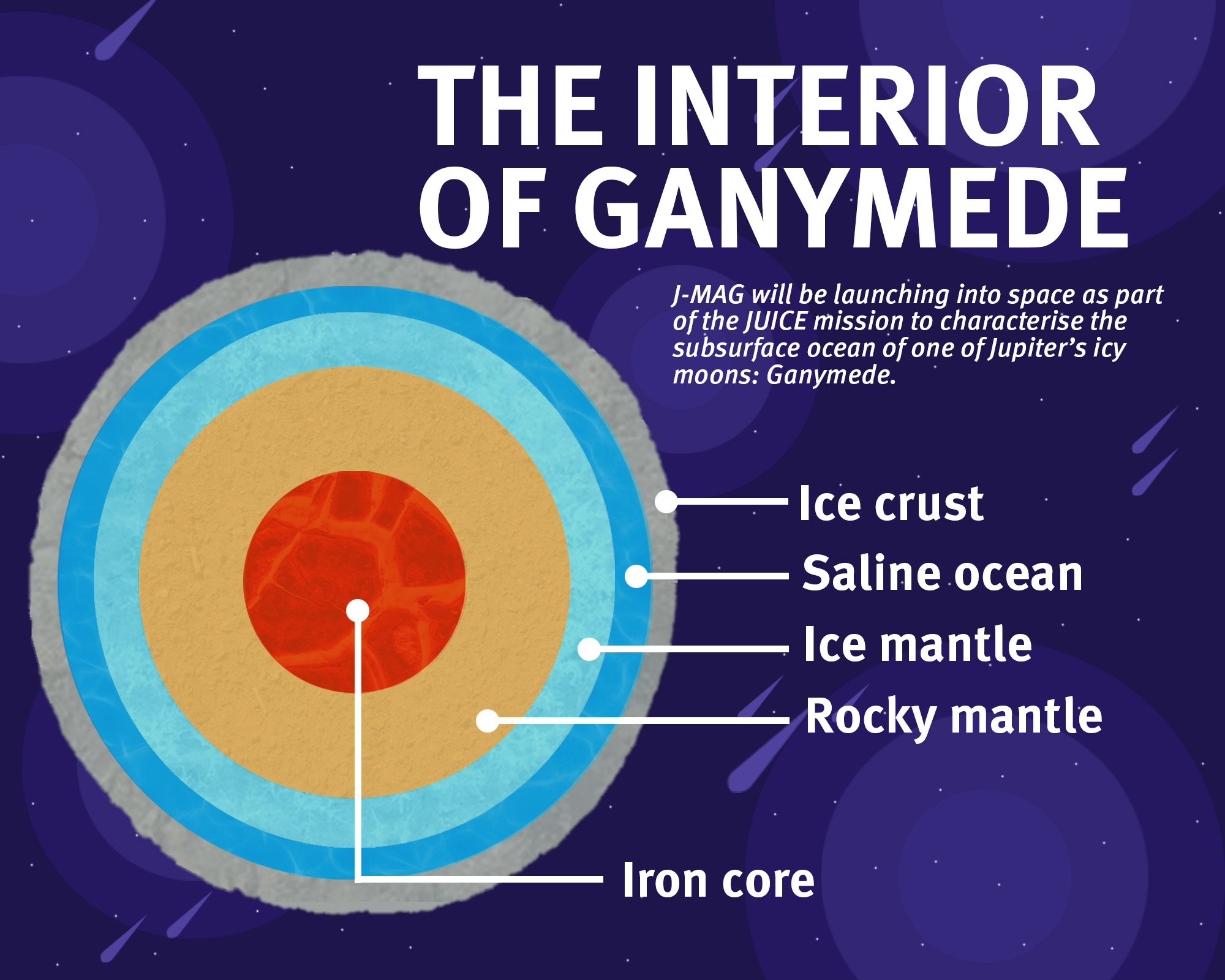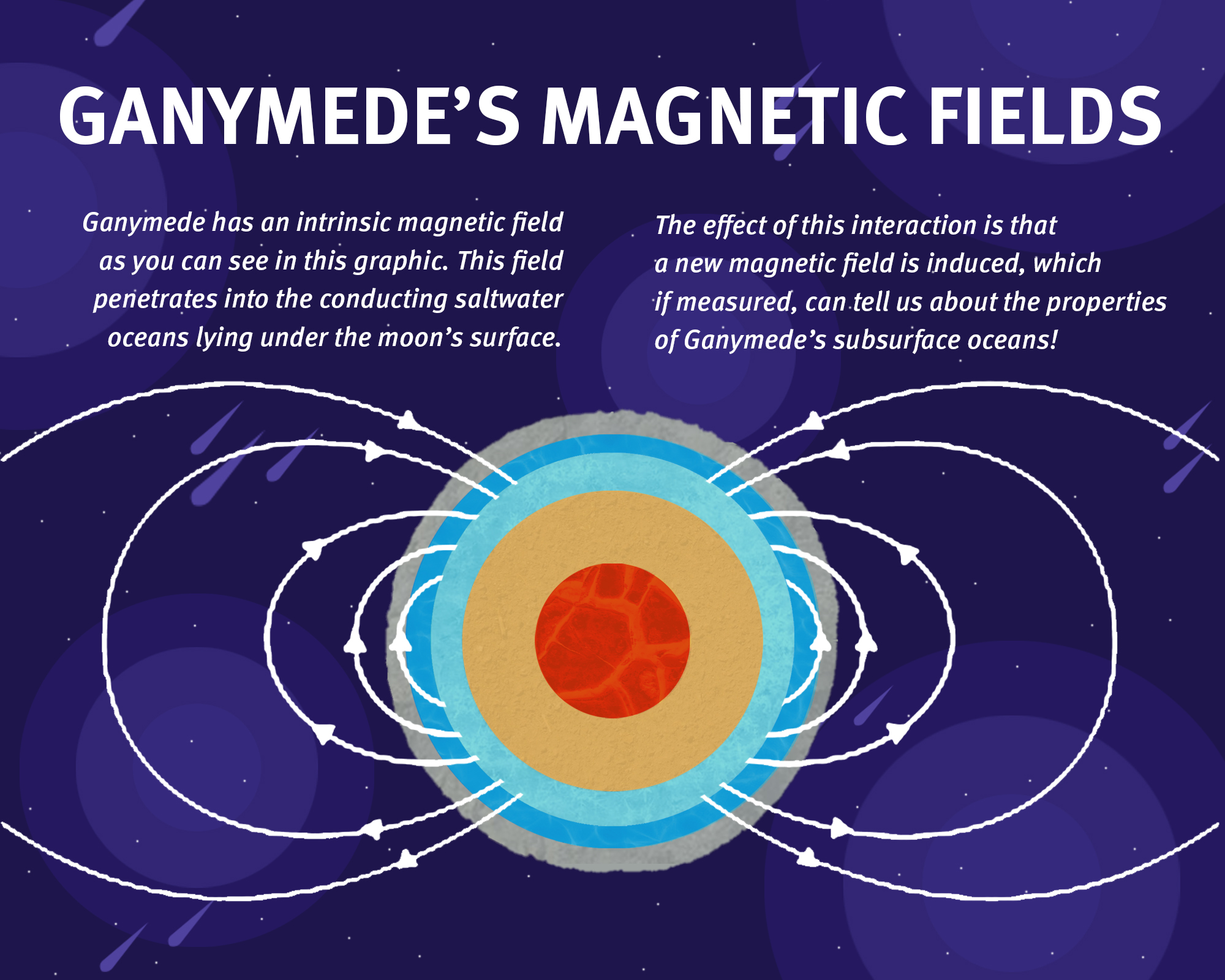Ciaran Jones and Matthew Acevski are final-year MSci students from the Department of Physics who helped model aspects of the JUICE mission, launching on 13 April, which will explore the icy moons orbiting Jupiter. In this blog post, they tell us the science behind Imperial’s instrument aboard the mission: JMAG.
By Ciaran Jones and Matthew Acevski
The European Space Agency’s Jupiter Icy Moons Explorer (JUICE) mission promises to be one of the most exciting feats in space exploration. Due to launch on 13 April 2023 onboard Arianespace’s Ariane 5 rocket, the spacecraft will use the gravitational fields of Venus and Earth to accelerate towards the outer Solar System. We expect JUICE to reach the Jupiter system by the early 2030s.
The key scientific objectives of JUICE are to characterise three of Jupiter’s moons: Ganymede, Europa, and Callisto to determine their potential habitability. We believe these moons contain liquid water, in the form of saltwater oceans, beneath their icy surfaces. And we know that water, as we know it on Earth, is a prerequisite for life to succeed. However, predictions for the thicknesses of these oceans are on the order of hundreds of kilometres – significantly more than Earth’s (a few kilometres).
Our names are Ciaran Jones and Matthew Acevski. We are final-year MSci students in the Department of Physics. In our final year project, we worked with Dr Adam Masters and Professor Michele Dougherty to create an advanced analytical model that describes the magnetic environment at Ganymede.
The two parts of the JUICE mission we focused on were a few of the close flybys of Ganymede as well as the last phase of the mission: a circular orbit of Ganymede at an altitude of 500 km (GCO-500).
To measure the magnetic fields, Imperial College London has developed the JUICE magnetometer (JMAG), and Professor Dougherty is the Principal Investigator for this instrument. The development of JMAG was not only a major scientific and engineering achievement but building it during the COVID-19 pandemic highlights the resilience and determination of our team here at Imperial.
Most of our understanding of Jupiter and its satellites comes from the Galileo mission, which reached the Jupiter system on 7 December 1995 and concluded its investigations roughly a decade later on 21 September 2003.
This mission provided the first evidence for subsurface oceans on Ganymede, Europa, and Callisto. The evidence to support the existence of these subsurface oceans comes from observations of ‘electromagnetic induction’.
This occurs when an electrical conductor is exposed to a magnetic field that changes over time. Induced magnetic fields are also created when a conductor moves through a static magnetic field.
What do magnetic fields tell us about the existence of oceans on Jupiter’s moons?
A time-varying magnetic field can penetrate a conductor – in this case the subsurface oceans on Ganymede – and generate an electric current described by a natural law known as Faraday’s law. Through Lenz’s law, the flow of electrons in the conductor produces a magnetic field that opposes the external varying magnetic field. In other words, it points in the opposite direction.
The moons that the JUICE mission will be surveying have two forms of induction: primary and secondary induction. The primary induction is due to Jupiter’s rotating magnetic field, tilted approximately 10 degrees to its spin axis, which rotates once roughly every 10 hours.
Secondary induction is due to each moon’s ‘eccentric’ orbit (meaning that the orbit is elliptical). The degree of eccentricity of these moons is very small, such that the time-varying magnetic field is much weaker than the one generated by primary induction.
Measuring these weak electromagnetic induction signatures is a prime functionality of JMAG, which has a precision of roughly 0.1 nano-Tesla. For comparison, over a million times smaller than the field strength of an average fridge magnet.

We can study the interior of Ganymede by observing its primary and secondary induced magnetic fields. As Ganymede orbits Jupiter every 172 hours, JUICE is expected to perform several close flybys throughout the mission’s timeline, with closest approach altitudes ranging from 400 km to 900 km, aiming to confirm the existence of the ocean and estimate its depth.
Towards the end of the mission, JUICE will enter a low-altitude Ganymede circular orbit at 500 km to probe its ocean’s properties before crashing onto its surface.
The depth of Ganymede’s ocean is predicted to be approximately 150 km, based on Galileo’s flyby observations. However, the thickness of Ganymede’s ocean is still unknown, with some studies estimating between 100 to 200 km, while others suggest thicknesses of about 500 km.
Modelling Ganymede’s saltwater oceans
We have used previous measurements taken by the Galileo flybys of Ganymede to validate our model’s performance. This comparison provided insight into where our model performed well and highlighted its limitations.
Our model best performs close to Ganymede, where the effects of external contributions that aren’t included in the model are negligible. So, its performance is adequate for the close flybys and the GCO-500 phase!
Our predictions for the closest JUICE flybys of Ganymede investigated whether these could provide evidence of a ‘dynamical induced dipole’ driven by the changing magnetic field of Jupiter.
A dipole is created when there is a separation of electric charge. One region becomes positively charged and the other is negatively charged. A dynamical dipole is simply one where those regions are constantly fluctuating as time goes on. This dynamical dipole is a consequence of the rotation of Jupiter’s tilted magnetic field which causes electrical charges to move around – creating positively and negatively charged regions.

However, the timing and location of these flybys relative to Jupiter’s current sheet are crucial. The former must be such that we observe different phases of the induced dipole. The flyby must be at a time when Ganymede is sufficiently far from the centre of Jupiter’s current sheet. The charged particles that surround Jupiter in a thin sheet can cause numerous interesting but challenging phenomena, such as magnetic reconnection, turbulence, and plasma instabilities, which provide significant magnetic fluctuations. These fluctuations could render these flybys impossible to analyse.
We analysed the total and induced magnetic fields for the GCO-500 phase and highlighted the main signals the JUICE team should expect to observe during the mission. This will be crucial for identifying specific signals, such as the secondary induced magnetic field.
Our investigation of secondary induction has considered many variations of ocean conductivity, depth, and thickness, highlighting limiting cases where the average signal drops below the precision of JMAG. The most common predictions of these parameters, however, are well within JMAG’s precision, meaning that we predict that JUICE will be able to successfully determine Ganymede’s subsurface ocean properties!
3, 2, 1… Liftoff!
The highly anticipated launch of JUICE is expected on 13 April 2023 from French Guiana in South America. It is planned to reach the Jupiter system in the early 2030s and make its first flyby of Ganymede in mid-2031. The primary objectives of JUICE are to investigate the magnetic fields at Ganymede, Europa, and Callisto and their potential habitability.
The mission is scheduled for two Europa, twelve Callisto, and at least eight Ganymede flybys before insertion into the Ganymede system via elliptical orbits. The observations at Europa and Callisto flybys aim to investigate factors like the geology and composition of the active surface of both moons, their exospheres, and their subsurface.
JUICE’s insertion into orbit around Ganymede will occur around January 2035, starting with Ganymede elliptical orbits, followed by a high-altitude Ganymede circular orbit at 5000 km (GCO-5000).
The main objectives during this phase are to study its geology and surface composition with many other instruments contributed by institutions across Europe. JUICE will also examine the plasma environment around Ganymede and its interaction with Jupiter’s magnetosphere.
JUICE’s main data acquisition of Ganymede’s magnetic environment will take place during the GCO-500 phase. It will aim to minimise the current uncertainty of Ganymede’s intrinsic field model and measure weak induction signals generated by its subsurface ocean.
JUICE is expected to end its mission by crash landing onto the Ganymedean surface around mid-late 2035 after providing us with four years of crucial data that will hopefully help us tackle the mysteries of the moon systems right here in our Solar System.